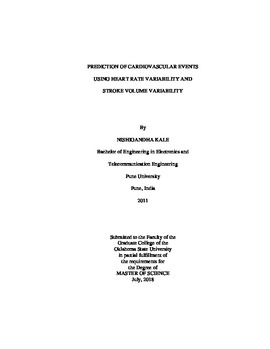| dc.contributor.advisor | Thomas, Johnson P. | |
| dc.contributor.author | Kale, Nishigandha Pralhad | |
| dc.date.accessioned | 2019-03-25T20:05:30Z | |
| dc.date.available | 2019-03-25T20:05:30Z | |
| dc.date.issued | 2018-07-01 | |
| dc.identifier.uri | https://hdl.handle.net/11244/317716 | |
| dc.description.abstract | Many firefighters die of heart attacks while on duty or even after they have left the profession because of the stress their job puts on their body. Heart attacks were the primary reason of active firefighters' death. Given that other fields like the military and police have similar high levels of stress at work, it is more likely that those who work in these fields are also susceptible to heart attacks. This calls for close monitoring of the heart condition of such people working in highly stressful environments. | |
| dc.description.abstract | Currently, there are many ways to monitor and measure the health of a heart. One way is to measure the state of the heart is by analyzing heart rate variability (HRV) and Stroke Volume Variability (SVV). Although our long-term goal is to develop a Fire Rescue network to identify on duty firefighters at risk, our preliminary work has focused on people from all walks of life. The first step is to analyze heart rate variability signals of healthy and unhealthy patients to predict a cardiac event with the best sensitivity and specificity. Using machine learning algorithms, we can predict a patient's heart health using Heart Rate Variability (HRV) and Stroke Volume Variability (SVV). Heart Rate Variability (HRV) is different for a human in different postures and physical conditions. Our study also focuses on Heart Rate Variability (HRV) analysis of patients' data while they are sitting and lying because patients' health can be predicted using machine learning algorithms on heart data collected in different postures. | |
| dc.description.abstract | Our result showed that both HRV and SVV analysis predictor variables on the random forest model produces better sensitivity and specificity. Results showed that a distinction could be made using machine learning techniques between postures, healthy and unhealthy people by analyzing HRV and SVV signals. | |
| dc.format | application/pdf | |
| dc.language | en_US | |
| dc.rights | Copyright is held by the author who has granted the Oklahoma State University Library the non-exclusive right to share this material in its institutional repository. Contact Digital Library Services at lib-dls@okstate.edu or 405-744-9161 for the permission policy on the use, reproduction or distribution of this material. | |
| dc.title | Prediction of Cardiovascular Events Using Heart Rate Variability and Stroke Volume Variability | |
| dc.contributor.committeeMember | Cline, David | |
| dc.contributor.committeeMember | Benjamin, Bruce A. | |
| osu.filename | Kale_okstate_0664M_15911.pdf | |
| osu.accesstype | Open Access | |
| dc.description.department | Computer Science | |
| dc.type.genre | Thesis | |
| dc.type.material | text | |
